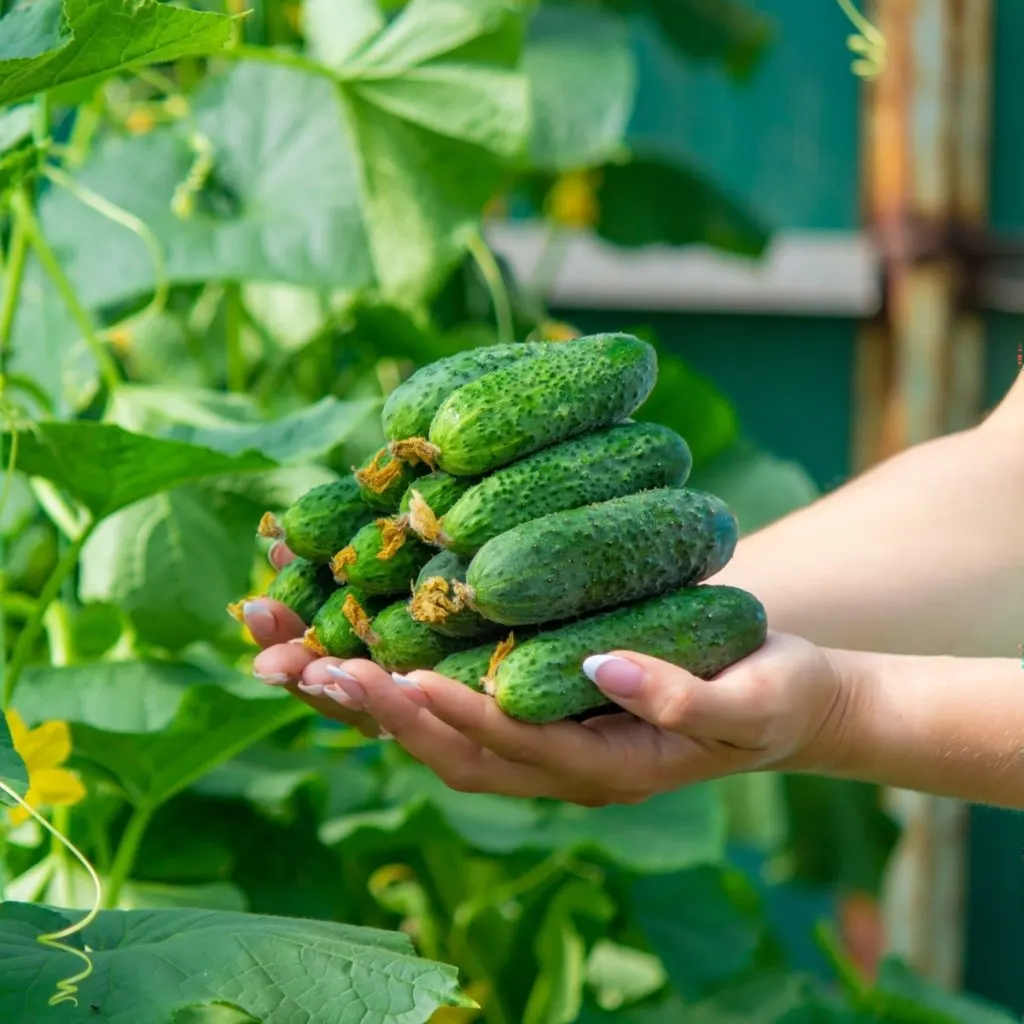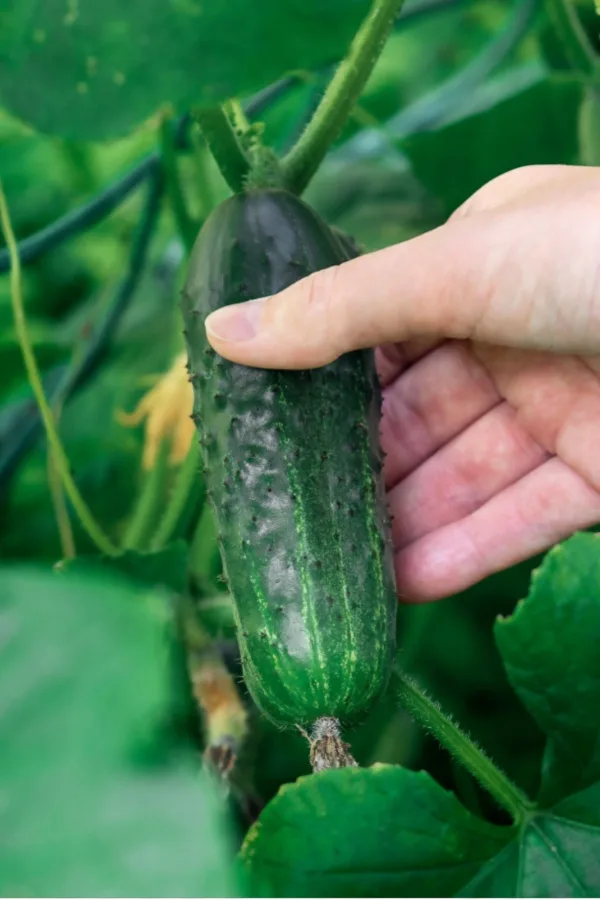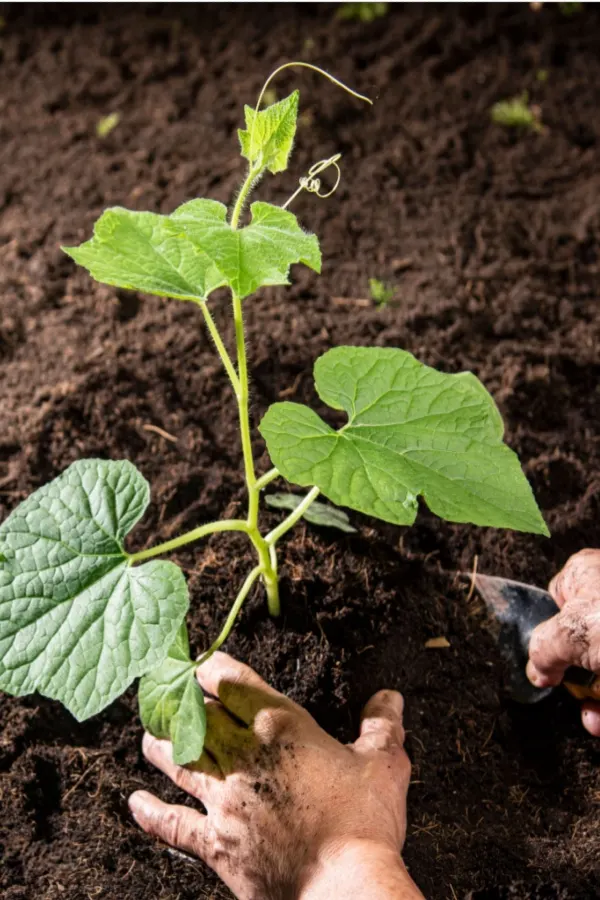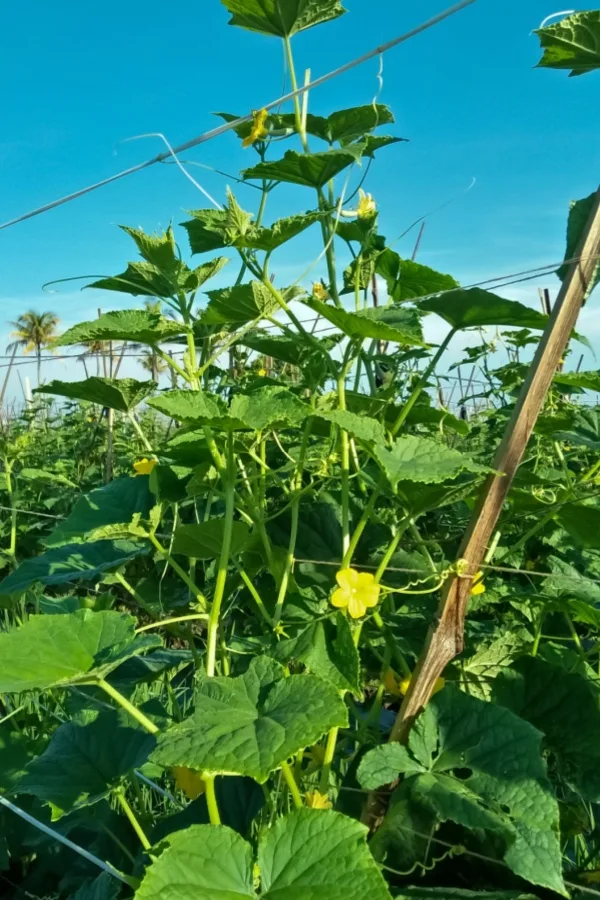If you are looking to grow and harvest a fantastic crop of cucumbers this year – the path to success all begins with knowing how to fertilize your cucumber plants with the perfect mix of nutrients at just the right time!
As garden season approaches, gardeners everywhere begin planting cucumber transplants or seeds into the soil. Whether you plant them in a traditional backyard garden, in raised beds, or even in pots or containers, when given the proper care and the correct nutrients – cucumber plants will respond with healthy and productive growth.
But knowing both how and when to fertilize can make a huge difference in the health and vitality of the plant. Even more importantly it can have a huge impact on the number of cucumbers that it produces as well.

Fertilizing is critical at every stage of a cucumber plant’s life cycle – not only when they are first getting established in the ground, but also as they begin to flower and fruit.
The first task is making sure the plants start off healthy. That means giving them the right mix of nutrients to build strong roots and thick foliage. But as the plants begin to flower and fruit, the method and type of fertilizer needs to change to meet the goal of more blooms – and more cucumbers!
The Best Way To Fertilize Cucumber Plants
Cucumbers plants have specific nutritional needs at three key stages of their growth cycle.
- At planting time: This provides the foundation for healthy root growth.
- Early growth (6-8 weeks): This provides nutrients to support strong plant development.
- Fruiting stage: To encourages abundant and healthy fruit production.
By understanding these stages and delivering the right nutrients at the right time, you can significantly boost your cucumber harvest. Here is a look into each stage and how to optimize your plants’ health and overall yield by giving it the power it needs. The good news is that it’s simple and easy!

Fertilizing At Planting Time – The Best Way To Fertilize Cucumber Plants
Whether you are planting from seed or transplants, fertilizing starts on planting day. The key to getting them off to a great start is to provide adequate nutrition directly into the planting hole.
For an initial boost – there is no better choice than 100% natural compost. Compost is truly the champion when it comes to slow release fertilizers. It is loaded with a perfect balance of easy to absorb nutrients to get your plants off to a strong and healthy start.
However, just as important, it helps to retain moisture beneath the surface of the soil. This moisture is vital to help cucumber seeds germinate and the roots of transplants to take off. See our article: How To Build The Perfect Spring Compost Pile
So how much compost should you use? If you are mounding the soil and planting cucumber seeds, use an even ratio of soil and compost. Be sure to mix the two ingredients well when creating the mounds. Affiliate Link: Charlie’s Organic Compost
If you are planting cucumber transplants you grew from seed indoors or purchased at a garden center, start by digging your planting hole three to four times the size of a cucumber plant’s root ball. Then fill the hole with equal amounts of soil and compost.
Listen To Our Podcast On Growing Great Cucumbers!
Mulching Your Plants For Power – How To Fertilize Cucumber Plants
The next important step is to mulch – whether you plant transplants or seeds. Not only will it help keep weeds from forming, it also helps regulate the soil temperature and moisture. But even more, it gives you the chance to add more power for your plants! This involves using two simple ingredients – compost and worm castings.
Start by layering one to two inches of compost around each plant or planting hill. A circumference of 6 inches of compost around each plant is ideal. Then sprinkle a quarter cup of worm castings over the compost area.
Worm castings provide a slow steady supply of nutrients that are easily absorbed by the plant’s roots when they get rain or water. This provides young transplants and seeds a huge jump start in healthy growth. Affiliate Link: Pure Worm Castings
After putting down the compost and worm castings, apply a layer of mulch (straw, shredded leaves, etc.) on the top surface. If planting seeds, use only about 1/2 inch of mulch until plants come through the soil. For transplants, mulch with three to four inches on top of the compost and worm castings.

Fertilizing Cucumber Plants As They Grow
Once your cucumbers are beginning to grow, the next step is to provide them with consistent but light applications of fertilizer. It’s very important to remember those two words, consistent and light.
If you give plants too much energy at once, they will spend it all developing stems and leaves – and not blooms. And without blooms, there are no cucumbers.
This is why a consistent but light application of fertilizer works best. It gives plants adequate nutrition to keep them healthy and strong, but not so much that they become overgrown with massive amounts of foliage.
How To Fertilize Young Cucumber Plants During Early Growth
Approximately two weeks after planting transplants, start to fertilize with a light dose of liquid fertilizer. Then continue this routine every two weeks throughout the season.
Liquid fertilizers work in two ways. First their nutrients are absorbed by the leaves of the plant. But the roots can also absorb the nutrients when the liquid fertilizer is provided at the base of the plant. This dual action allows the cucumber plants to get energy quicker as compared to using granular fertilizers.

If you planted seeds, allow them to germinate and grow a few inches high and develop 3 to 5 leaves before applying the the first dose of liquid fertilizer. Remember the key here is using liquid (not granular) fertilizer.
Using The “Right” Liquid Fertilizer – How To Fertilize Cucumber Plants
It’s important that once your plants have begun to take off to use a fertilizer with a bit less nitrogen and more phosphorous and potassium. This will help the plant then refocus energy on creating fruit and not just strong vines and leaves. (Affiliate Link: Jack’s Bloom Booster 10-30-20 Fertilizer)
Nitrogen is specific to helping plants grow. And a supply of it is necessary to help cucumbers continue to grow. But phosphorus and potassium are key for helping in flower and fruit production, and there needs to be more of these two nutrients than nitrogen. Look for liquid fertilizers like that have double or triple the amount of phosphorous and potassium to nitrogen.
Last but not least, since you want to feed consistently but in lower doses, dilute the liquid fertilizer to half of the recommended strength. This will allow you to fertilize every two weeks but not overpower the plant.
Here is to powering your cucumbers this year to a bigger and better harvest!
Simple Garden Life
Follow Our Facebook Page For Even More Great Tips! Simple Garden Life Facebook Page
Simple Garden Life is a website dedicated to keeping gardening fun, simple and enjoyable! We publish two new articles each week along with a new garden podcast episode every two weeks. This article may contain affiliate links.
